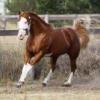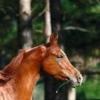Beginning Genetics: Getting Started with Coat Color Genetics

step 1

step 2

step 3

step 4
Color genetics is the study of the genes behind coat colors. Since genes determine the way colors express and the way they are inherited, in order to understand color genetics, it is necessary to understand some very basic genetics.
Genes are the building blocks that make up our DNA. Each gene is made up of two alleles. One allele inherited from the male parent and one from the female parent. Alleles are responsible for every physical trait. Those we can see and those that we can't see. Not every allele is expressed. Some are masked by other alleles, but can still be passed on to offspring. Alleles can express in different ways, and the first two we will discuss are dominant and recessive.
Dominant (sometimes referred to as simple dominant): Only one copy of the allele is required to express. For example, let's consider an imaginary allele P that is dominant. If an animal (or person) carries this allele, and it is not masked by another gene, it will express. It doesn't matter if one or two copies are present, it will still express the same way. The notation of this would be PP for two copies of the allele Pp for one copy (PP and Pp will look the same, the trait will express)and pp if the allele is not present.
Recessive: Two copies of the allele are required to express. This time, we will designate our trait b. (Did you notice that it is lower-case this time? Recessive alleles are designated with lower-case letters, while dominate alleles are upper-case.) Because the allele is recessive, it will only express if the offspring inherited a copy from each parent bb. If the offspring only inherited one copy (Bb) the trait will not express. It will look exactly like an offspring who does not carry the trait at all (BB).
Now let's looks at some Punnett Squares. A Punnett Square is a tool used in genetics to calculate inheritance probabilities. They can get quite complicated, but don't panic. We'll keep it simple.
In order to use a Punnett Square, start at the top left, dam's allele. Travel across to the right and combine the dam's allele with the first sire allele. Write them in the box. Combine the same dam allele with the next of the sire's alleles. Write them in the next open box on the top row. Continue to the next row and do the same thing with the dam's alleles in that row and both of the sire's alleles. In this way, you combine each of the dam's alleles with each of the sire alleles. Making four (4) possible combinations. Because there are four possible combinations and the total has to reach 100%. Each outcome will have a 25% chance of occurring. If one of the combinations occurs more than once, those possibilities are added. For example, in the square we just completed, Pp occurs twice. This means that the chances of Pp occurring is not just 25% but 50%. We now have all the possible outcomes, plus the possibility that they will occur in any breeding where the sire and dam are both Pp. Since the example we are dealing with involves a Dominant trait, the trait will show in 75% of the offspring (assuming there are not other genes that mask this trait). The trait will express in the offspring that are PP and Pp. How does that add up to 75%? Well, remember that each outcome has a 25% chance of occurring and since the Punnett Square has three boxes with the dominant allele, we can simply add those chances together to get 75%. Clear as mud? Then let's move on...
With a recessive allele, the Punnett square works the same way. The difference is how the allele expresses. Let's look at our recessive example with two Bb parents. The possible outcomes for offspring are BB, Bb(two of these), and bb. In this example, only one out of four of the possible outcomes will express the trait, the bb offspring. Since each has a 25% chance of occurring and bb only occurs in one square, there is only a 25% chance of the trait expressing.
Now that you understand dominant and recessive, we can move on to incomplete dominant and co-dominant.
Incomplete Dominant: This mean that when the allele is present only once Rr it will express but it will express incompletely. For example, in a snapdragon flower if two copies of the red allele are present, RR the flower will be red and if the red allele is absent, rr the flower will be white. If however, there is one red allele present, Rr the flower will be pink.
It is common, even though an organism can only carry two alleles of any one gene, for more than two alleles of that gene to exist in the general population. It is standard practice to designate these alleles with the locus (the location on the chromosome where the alleles occur) and a superscript. For example, in humans, blood type is determined at the I locus. Therefore, IA,IB,and IOare used to distinguish the alleles, but only two of these alleles can be present in any one person. A person can be IAIA (Type A Blood),IAIO (type A blood since IOis recessive to IA), IBIB (type B blood), IBIO (type B blood since IOis also recessive to IB), or IOIO but not IAIBIO. A person can also be IAIB which is type AB blood. In this case, neither the A or B is recessive to the other. They are what is known as co-dominant meaning that the traits combine to form the final expression. Co-dominance is different from incomplete dominance. In incomplete dominance the recessive allele doesn't produce red pigment, this results in a pink flower because the recessive allele doesn't contribute. In co-dominance both alleles contribute to the final expression.
Genetics can be a daunting subject but building anything including understanding starts with the foundation. The foundation we've just covered is all you need to get started learning color genetics. If you choose to go no farther, you will still be able to understand how inheritance works and how it can be applied.
Comments Page
Homozygous
Your stallion cannot be homozygous for the pinto gene due to his sire being a solid Friesian. He may however have a chance of being homozygous for black (if dam was a black-based horse). Homozygous essentially means "two copies" of the same gene - so if both parents don't have the gene to pass on, the resulting foal cannot be homozygous.
You don't say what pinto pattern the parents express: Tobiano? Frame? Splash? Sabino?
The foal will likely be either bay or black (with a possibility of being homozygous for black) - but without knowing the pinto patterns of the parents, I cannot comment further on the likely pattern of the foal.
Lisa
I would like to use a photo
I would like to use a photo of your cat; if you have one I may use please contact me here http://colorgenetics.info/contact



Homozyguos
Hi I need help,I have a stallion,he is a black and white pinto.His sire was a solid black friesian and the mare was a pinto crossbreed. Is there a chance of him being homozyguos+?
This black and white stallion was bred to a bay pinto mare ,her dam was a friesian and sire was a bay pinto saddler.What is foal goin to be? Might the foal be homozyguos?